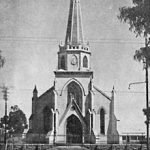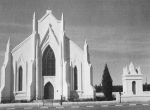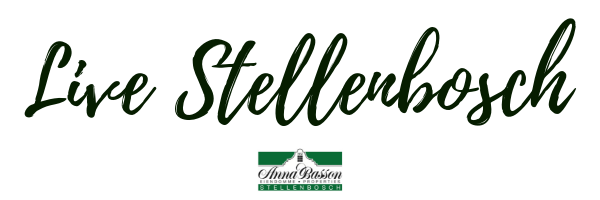Architect and artist
I think Carl Otto Hager would've been suprised that the old Lutheran church on the corner of Dorp Street and Bird Street is an art gallery today. He was himself a portrait painter and photographer. The small church is 163 years old and is one of Stellenbosch's most beautiful heritage pieces.
Carl was born in Dresden, Germany, in 1813, and displayed a special artistic talent since he was a small child. He was only 15 when he started his studies at the Dresden Academy of Fine Arts. Some sources say he was trained as a portrait painter, others as an architect.
When Carl was 25 years old, he decided to emigrate to the Cape Colony together with a student friend. The two friends worked and lived in the Cape for a number of years, but Carl later relocated to Stellenbosch, a place that reminded him of his 'fatherland' and somewhere where he could find peace. He was a deeply religious man. Carl married a music teacher Cornelia Janssen, and made a (humble) living as a portrait painter, a candle maker, a snuff maker and later a photographer. In 1846 he opened a photographic studio in Stellenbosch. It is believed that for a while he worked as a travelling portrait painter, travelling on horseback.
Did you know? The architect Carl Otto Hager designed more than 24 churches and other structures around South Africa. He used the design of the Lutheran church to inspire similar church buildings in Ladismith, Clanwilliam and Fraserburg.
His biggest legacy is however his architectural work. The Evangelical Lutheran church was completed in 1854, and unlike many of the first church buildings in South-Africa, this building was whitewashed and had a thatched roof. The church was designed in the Neo-gothic style (i.e. the finials on the facade as well as the pointed windows mimic the Gothic style of the late medieval period).



The German community in Stellenbosch
The small German faith community in Stellenbosch offered a spiritual home to Carl and his wife. In the Cape there had been a Lutheran church for a number of years - some of the free burghers were from German descent, and although many of them learned to speak Dutch, they desired to have their own church. The farmer and entrepreneur Martin Melck - a historical figure I'll write about later - built Cape Town's first Lutheran church in 1771 in secret because it was in opposition to the policies of the V.O.C at the time.
When Stellenbosch started raising funds for its own Lutheran church (1851), Carl Otto Hager offered his skills as architect free of charge. At this stage he was 38 years old.
Hager designs 'Moederkerk'
Ten years later he would also design and oversee the expansion of the current Mother Church (Moederkerk) (1863). This project brought his competency as architect into the public eye, and secured him many similar commissions in the years to come. Carl later also designed the Ou Hoofgebou, the original Victoria College.
The Lutheran congregation gathered in the little church in Dorp Street for many years. The community was too small to sustain its own priest, but one of the priests from the Cape congregation traveled to Stellenbosch on weekends to lead the service. Alternatively a church council member oversaw the liturgy. Carl Hager was a deacon himself and led the service for almost two years. A couple of years after its establishment the church installed an organ which was inaugurated with the choir of F. Hauptfleisch. Hager died in 1989 and was buried in the cemetery at Papegaai Mountain.

The Lutheran church becomes part of Sasol museum
More than 100 years later (1969) the little church faced the possibility of being demolished and was purchased by the Historical Houses of South Africa Ltd. (by Mr and Mrs Anton Rupert). It was restored to its former glory and donated to the university. In that same year it was formally inaugurated as an art gallery. When the old Bloemhof School was restored and put to use as an art Museum, both the school and Lutheran church came under the management of the Sasol Museum (now the U.S. Museum).
Did you know: Before the art department had its own building, fine arts classes were taught in the Ou Hoofgebou (today the law faculty). The department's first home was the Denne-Oord building on the corner of Victoria and Neethling Street (where the conserve is today), and in 1975 it moved to the old Paul Roos building where it still is today (Matieland 1984).
The building adjoining the Lutheran Church was bought and restored in 1983 as an annex to gallery (Matieland 1984). Apparently the original objective for the annex was to house the work of the local artist Maggie Loubser. When the Old Bloemhof school was re-opened as art museum, it was decided to rather preserve the permanent collections there - the Lutheran church gallery would then be used for alternating exhibitions. Maggie Loubser's collection can still be seen at the US Museum today.
Lutheran church becomes 'GUS'
Today the old Lutheran Church goes by the name of GUS (Gallery of the University of Stellenbosch). The space has been under the management of the Dept Visual Arts since 2014 and the work exhibited there is mostly of an academic nature. The space is used to host postgraduate examinations, the annual postgraduate colloquium, as well as the annual Gradex auction.
Anyone is however welcome to submit a exhibition proposal for consideration by the Gallery board. The beautiful new logo and corporate identity (left) was designed by the Stellenbosch graphic design student, Jeanne-Marie Roux, as part of her 4th year project. For more about her work click here.
